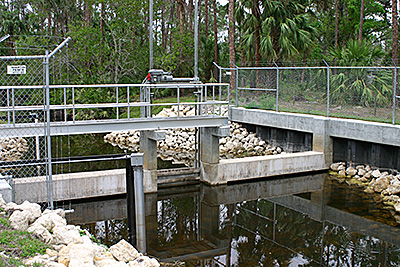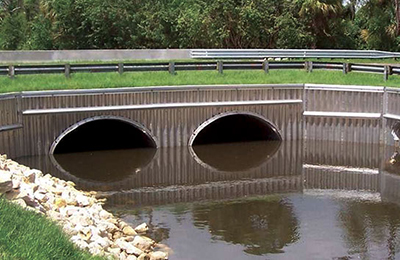Stormwater Management
 The District has a tremendous responsibility in the proper management of a large volume of stormwater runoff. Each year the District receives, on average, 60 inches of rain. It is important to manage the flow of this volume of water through the District's canals for maximum protection and benefit to property owners. The District's surface water management system is designed, operated and maintained for a mostly rural residential community with some commercial, industrial and urban residential areas.
The District has a tremendous responsibility in the proper management of a large volume of stormwater runoff. Each year the District receives, on average, 60 inches of rain. It is important to manage the flow of this volume of water through the District's canals for maximum protection and benefit to property owners. The District's surface water management system is designed, operated and maintained for a mostly rural residential community with some commercial, industrial and urban residential areas.
Every effort is made to conserve the stormwater runoff generated from rainstorms by directing its flow into the natural holding areas in and around the District, such as the slough, water catchment areas and wetlands. South Indian River Water Control District is responsible for maintaining over 376 miles of swales and canals.
The drainage system, maintained by South Indian River Water Control District, operates by gravity flow. First the water flows from impervious surfaces such as roofs, driveways and roadways into ponds, natural depressions and swales. This initial drainage is referred to as the "tertiary" system. Any stormwater that is not held by the swales and absorbed into the ground, moves eastward across the District through a network of maintained canals and is known as the "secondary" drainage system. The final movement of the water is into the "primary" drainage system that consists of larger canals, such as the C-18, and the Loxahatchee River. The primary drainage system is the responsibility of the South Florida Water Management District.
It is important to understand that after heavy periods of rain it is normal for water to remain standing in the swales. This is the way the system is designed to function and allows for natural infiltration into the soils below to help filter pollutants and recharge groundwater. Standing water can occur when the ground becomes saturated and cannot absorb any more water. Continued development of low-lying areas of the District will result in reduced storage capacity within the District's watershed and thereby increases stormwater runoff.
 Even with the heavy amounts of rain, such as the Thanksgiving week storm in 1995 where the District experienced over 20 inches of rain, and multiple hurricanes that impacted our area over the years, the system has functioned well. The 1995 storm produced a higher level of rainfall than is normally anticipated in a 100-year storm, which is what the system was designed to handle.
Even with the heavy amounts of rain, such as the Thanksgiving week storm in 1995 where the District experienced over 20 inches of rain, and multiple hurricanes that impacted our area over the years, the system has functioned well. The 1995 storm produced a higher level of rainfall than is normally anticipated in a 100-year storm, which is what the system was designed to handle.
Maintaining the culverts is a major responsibility of South Indian River Water Control District. The District is engaged in a program of upgrading and replacing culverts in canals throughout the District. In addition, the District installs riprap to support and stabilize slopes on canals to minimize erosion. Maintenance of driveway culverts is the responsibility of the landowner. Landowners must notify the District when their culvert has been crushed or has collapsed and is no longer functioning. This is important to ensure proper stormwater management. South Indian River Water Control District offers a Driveway Culvert Replacement Program for landowners.
South Indian River Water Control District has an Aquatic Weed Control Program to maintain the primary canals. This is an ongoing process aimed at reducing and managing the amount of vegetation in the canals, road swales, and other stormwater management features in the network to allow unobstructed drainage following rain events. The program controls emergent aquatic vegetation growth using herbicides approved in permits obtained from the state of Florida, as well as mechanical removal of dead or accumulated vegetation that may present potential for impeding the flow of stormwater in the primary canals.
In the future, greater emphasis may be needed for this program as a result of National Pollutant Discharge Elimination System water quality programs, the Florida Department of Environmental Protection and Environmental Protection Agency proposed stormwater criteria, the Ecosystem Management Area Plan, and other governmental coordinating activities.
It is important that residents report any blockage in the canals and to refrain from dumping trash, agricultural waste, tires, old toys, recreational equipment, appliances and all toxic materials into the canals or on vacant lots. It is illegal and can result in heavy fines. Please notify the District if you see illegal dumping.
For more information on stormwater including South Florida Water Management District links, tips on what you can do to reduce runoff and improve water quality, the National Pollutant Discharge Elimination System, Environmental Protection Agency guidance and much more, click on the Resources tab above and select one of the Stormwater Information links.